#but just making it more present more controversial Just to disturb his readers who sometimes have no real use for the script.
Text
If Fumiko is monstrous then Fujimoto should start presenting her as such
Fumiko is written to remind us that Denji is a child, and I repeat, she is the symbol of a child's sexual trauma in all its horror and "paradoxes".
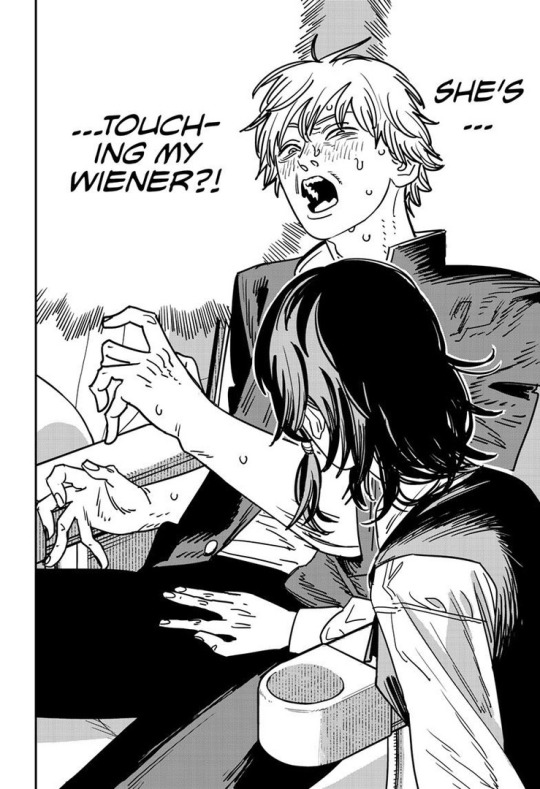

Touching Denji without his consent, catching an adolescent who hasn't yet discovered himself off guard, is the most obvious way of proving the link between the theme of sexual assault and Fumiko, but it doesn't stop there.
The fact that Denji accepts only proves this point: it shows just how much he's someone who needs boundaries and protection. He passively listens to what he's told without question simply because Fumiko has the upper hand.

She has one, but spends her time pretending she doesn't, in particular by disguising her age like a predator, calling him "senpai" when she's 22, and playing up her protective role as a "bodyguard" when she's only there to stop Denji thinking for himself
As can be seen in the dialogue between Miri and Denji, she positions herself as an interlocutor, standing in Denji's shadow, influencing his decisions and distracting the boy from the substance of Miri's message.

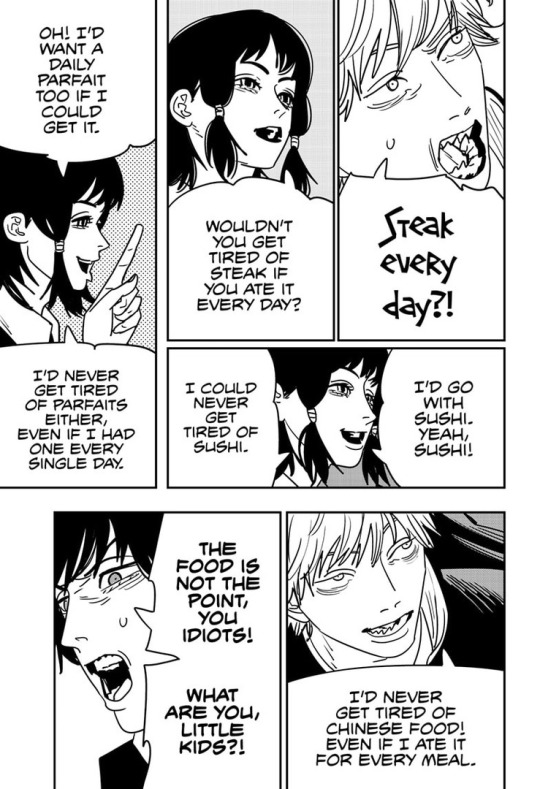
But she's a complete paradox, still trying to make Denji believe she's protecting him, she refers to Chainsaw Man as a "child", which rather than demonstrating a good intention shows that she's well aware of what Denji is and that she's abusing him head-on.
Who protects a child by attacking him?

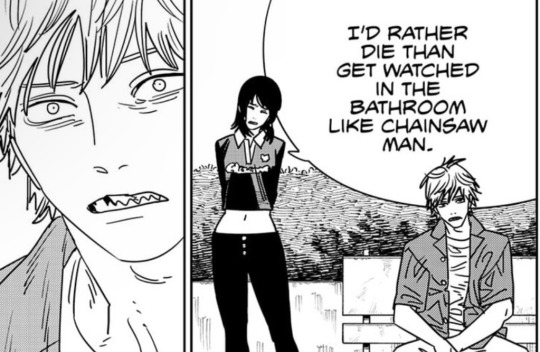
Once again, I insist, these are two pages from the same chapter. Dare you tell me that Fumiko doesn't present any contradictions?
Above all, she makes it seem as if she only wants what's best for Denji, even when he hasn't responded to her pleas for help. Once again, there's a paradox: the predator blames her victim for not having seen her own vulnerability, whereas she’s only abusing those of her victim.
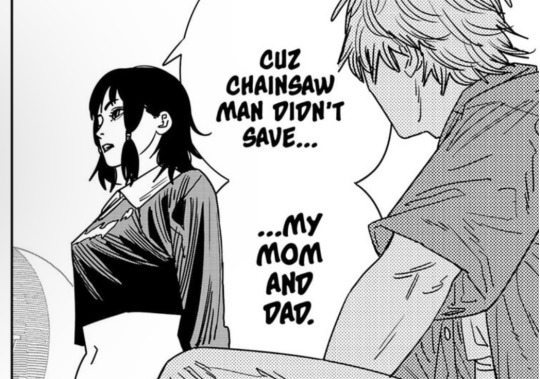
Fumiko is a metaphor for the very dangerousness of sexual assault, gentle on the surface but insidious, its violence only made clear and felt after the event, rising like a tide.

When Yoshida convinces Denji to give up his normal life, he leaves him in the hands of Fumiko, a public hunter, who symbolises the extent to which, despite the monster in front of them, danger also exists among men, and that the milieu of public hunters is a harmful world for a child.

I think the reason Fujimoto doesn't immediately place Fumiko in a position of condemnation is to instil a feeling of frustration and powerlessness at seeing Denji unprotected, to make it clear that "he's missing something", a parental figure.
But I think that for the writing to be complete, the author has to take a clear stance on the subject, in his own way of course, but explicitly
Seeing Fumiko next to Denji makes me anxious, it's such a common form of violence that it pulls me out of my reading.
Fumiko is a monster, so I pray that Fujimoto will have fun explicitly detailing her dark side and her horror.
If he doesn't, then she'll remain an unfinished and confusing chimera, the result of lazy writing and a fear of commitment.
#csm 136#csm 137#csm 139#csm 142#chainsaw man#csm#csm part 2#csm spoilers#denji#fumiko#fumiko mifune#my thoughts#But I'm a realist I can also see the flaws in an author I love Fujimoto likes the dissident and morally controversial aspect of his work#Even when the violence is correctly presented there will be no narrator to condemn it Fujimoto doesn't risk accentuating Fumiko's horror#but just making it more present more controversial Just to disturb his readers who sometimes have no real use for the script.#Maybe I'm being too hopeful and justifying the shortcomings of Fumiko's writing to reassure myself#It's possible she's the black spot in part 2#In a jump shonen you can't present a 22-year-old girl touching a teenager as a joke.#I'm in favour of creative freedom but I'm also in favour of authors being aware of their audience.
162 notes
·
View notes
Text
Lolita by Vladimir Nabokov: an Analysis and Review
Foreword
Trigger warning for themes of paedophilia, sexual assault, stillbirth, manipulation, violence, and tragedy as well as gruesome descriptions of death. If you want a review free of spoilers, please scroll to the section labelled ‘Conclusion/Review without spoilers.’
Introduction
Calling Lolita a controversial novel is a safe bet. Some readers revolt at its topic, others still protest it as the inspirational romance of the century. Both give Lolita a bad name. I will say it once very clearly; plot-wise, Lolita is a book about a paedophile who grooms, manipulates, isolates, and rapes a twelve year old girl. It is disturbing subject material to say the least, subject material that has to be given more thought than its protagonist’s ramblings of adoration for the book’s namesake.
For instance, despite its fluctuating reputation, Lolita has found itself to be a playful and humorous novel to many, a “...comedy of horrors” according to the San Francisco Chronicle. So what is Lolita, exactly? A comedy? A thriller? Both? It is time to examine this twisted novel and see just how tangled its thorns are.
Plot synopsis
Humbert Humbert is a typical man by most standards: a handsome, French writer and professor with a soft spot for road trips… and little girls.
Humbert categorises the sexes into the male, the female, and the nymphet, the latter of which describes peculiar young girls Humbert feels an intangible attraction to. It is with such a nymphet that Humbert self-describingly falls in love with; rambunctious twelve-year-old Dolores(whom he dons ‘Lolita). He cannot keep his mind off of her; ‘light of my life, fire of my loins.’ In however poetic a prose he may choose to describe it, Humbert feels a physical bond to young Dolores like to no one else since his dead childhood sweetheart. Humbert goes so far to pursue the girl that he marries her mother, whom he plots to drown in the blue depths of a lake to have Dolores all to himself. However, what Humbert describes as a work of fate led to the day Dolores’ mother’s brain lay strewn about the road, smeared by an incoming car. She didn’t need to be subject to Humbert’s schemes to die.
From there on, Humbert has legal custody over the twelve-year-old fire of his loins. Raping Dolores becomes a routine. Though she does initially say yes, she is a minor incapable of consent in the imbalance of a grown man with everything to lose if she is to either escape or stop the affair; she will lose her only family if she reports him, and risks breaking his heart if she cuts off the affair altogether-unfortunates only know what people do when they have nothing to lose. Orphaned and trapped, Lolita agrees to Humbert’s ‘love.’ As he described it, ‘she had nowhere else to go.’
Two years pass before Dolores falls ill during their second road trip and is taken out of the hospital by an uncle aware of Humbert’s affairs. By way of escaping with this newfound relative, Dolores is finally free from Humbert’s possessive grasp. Depressed by his separation from the girl, Humbert lives a miserable life for several years before receiving a letter from Dolores herself saying she is married and pregnant. Though Humbert suspects the man behind both titles is her own uncle, Dolores refutes this by saying that, though she was in love with him, they did not settle because she refused to be in his pornographic film.
Enraged with the uncle, Humbert arrives at Dolores’ uncle’s house and murders him before being arrested. It is here that we learn Lolita is Humbert’s autobiography of the events surrounding his ‘love’ for the book’s namesake. Though he wishes for the girl-turned-woman to live for a great many years, the victim, escapee, and survivor dies in 1952 during childbirth. Her offspring is a stillborn.
Analysis
It’s a curious thing, really. That so many interpret Lolita as a romance, I mean. Of course, it often presents itself in its writing as a summery romance to read on the beach. A handsome man meets a female. An attraction is felt. Male and female confess an attraction for one another which leads them on a series of road trips following the female’s mother’s incidental death. The language is no exception to this tone-just read the first paragraph:
“Lolita, light of my life, fire of my loins. My sin, my soul. Lo-lee-ta: the tip of the tongue taking a trip of three steps down the palate to tap, at three, on the teeth. Lo. Lee. Ta.”
It’s made up of beautiful, flowery sentences, language suggestive of the pure romance of a man ‘in love.’ With a twelve year old girl he rapes. Yes, Lolita is one of those novels that wears many outfits, its outermost lining being that of a tragic love story of one traumatised man and his ungrateful lover. This perspective is especially interesting when taking into account Lolita’s exquisite writing; could the flowery language have prompted so many to interpret this book as a romance? Could Lolita be representative of how so many wield words to distract or deceive those trying their best to disapprove of them? Either way, few deny that Humbert is lying, to himself or to the reader, of exactly how the events of his fascination with Dolores occurred. Digging further into the book, Lolita becomes an unreliable narrator’s documentation of the rape and manipulation directed toward a naive minor trying to cope with her mother’s death. Further still, it is a comedic satire of a paedophile’s attempts to justify his crimes... and failing miserably. “Ladies and gentlemen of the jury, I wasn’t even her first lover.” Deeper still and it’s one man’s search for his childhood sweetheart(dearest and deadest) he never finished loving, so he seeks, endlessly, to shower her lookalikes with unwanted ‘love.’ Without end. Without fulfilment.
Lolita is a story of infinite stories.
Review
What first struck me about Lolita was its beautiful writing; its eloquent prose, imagery, and metaphors hopelessly hooked me from the first paragraph. Nabokov never ceases to use amazing similes, description, and personification to amplify the reader’s experience of the goings-on of Humbert and the girl. This is especially striking in contrast to its tragic subject material; Humbert will rape, and he will manipulate, and he will scheme a murder, and he will hurt so many innocent lives, but he will do so with seemingly effortless grace in the scribbles on a paper.
Despite this, I did not find Lolita to be a difficult read regarding comprehension of the text. True, many a word I did not understand, but, despite this, I could always tell what was being communicated; the language is certainly not as dated as Hemingway nor Shakespeare. It may even be a calming read for those with a strong stomach, and will certainly teach a thing or two to those wishing to learn more about poetic writing styles done well.
Some may find the book to be lacking in terms of plot and overall excitement, but I feel this is a subjective view rather than a relatively factual one; Lolita is not an action book. Nor is it a drama. Humbert sometimes spends pages describing the exact locations of a road trip, or exactly how he earned money in the 50’s, and so forth. Some may find this mundane; I will admit that I was, at times, bored by it myself. However, what Nabokov sacrifices in brevity he makes up for with a profound understanding of Humbert’s emotions, environment, and thoughts.
One slight criticism I do, however, have, is that I found all of the characters in Lolita were fairly bland for me. True, Humbert is unique in his attempt to beautify the macabre, but beyond the initial shock factor of his morale and the revelation that he is seeking the love of a girlfriend from his childhood, Humbert can be mostly summarised as ‘quiet, manipulative, scheming, and possessive of Dolores.’ I was not invested in him as a character, probably due to a lack of good qualities within him; it is true that by one perspective, his story can be interpreted as tragic for him, though through the more common lens of Lolita being a 336-page manipulation of the severity of the atrocities of an evil man, Humbert loses all good qualities beyond his capabilities as a writer.
The same goes for Dolores herself, as I found her to be fairly two-dimensional; she is very sensory and seeks goods of food and adventure and she has a rambunctious heart unconcerned with how others’ feel nor how others perceive her. She is what many would call a ‘wild child,’ and though she becomes more withdrawn later in the book due to the numerous abuses she endured, I did not see much depth to her beyond face value.
That being said, I certainly do not think the characters are bad, just that they are underwhelming in comparison to the rest of the story.
I recommend Lolita to those enthralled by character-driven stories of nuanced emotions and traumas, a sort of story of the broken attempting to break the whole. If you are not put off by very thorough descriptions nor by a purposefully thin plot, I have the impression Lolita will revolt, horrify, hypnotise, and seduce its readers into its soft, macabre pages.
I give Lolita a rating of 90%.
Conclusion/Review without spoilers
Lolita is a vile, endlessly layered story of trauma and the endless search for lost love, horrific abuses, of humorous wit and smirking irony, and of one man’s endless destiny of deceit. I suppose Humbert’s own initials best summarise the smile and wink this book will deliver as you holler at Humbert, weep for Dolores, or perhaps even vice versa. They do say Russians are witty, and Nabokov does not fail this reputation even when we analyse how Humbert Humbert’s initials sound in the author’s native language:
Ha-ha.
14 notes
·
View notes
Note
1) Andrew is my fave and I love him to bits and relate to him sooo much (which is kind of horrifying I know), sooo I kinda have some issues with what you said. Something like "if you want andrew to heal then you don't really love him/neil doesn't want him to change: that's real love" like ok cool but... wanting our loved ones to feel better is a big indicator of love. Like if it weren't for people who wanted me to feel better I'd prob be dead rn. They didnt love a version of me that didnt exist
2) and wanted me to become. They loved my shitty self and wanted me to feel better FOR ME. Saying that if a reader wants a character to heal then they don't love that character is a bit disturbing. It sounds like the shit those asshole who fetishize mental health issues and suffering would say to me (some legit told me that if my parents send me to a therapist it's because they hate me and want me to change). I think that anon was legit, after years I too would want my fave to feel better xx
just like the other anon you rephrased what i said to reflect something i didn’t say at all. like i said in my previous post, it’s not about “if you want andrew to heal you don’t really love him” - it’s about “will you still love andrew if he doesn’t undergo changes that you define as “healing”?”
“if a reader wants a character to heal then they don't love that character“ (which i didn’t say) is not the same thing as “if a reader loves a character on condition that they change in a certain way and starts doubting their love if they don’t comply, it makes me wonder why they loved this character in the first place“ (which is what i was going for).
much less did i say that neil doesn’t want him to change. seriously guys where did you take all of this from? are we talking about the same post? i meant that neil loves andrew regardless of whether he changes or not and i think that’s very important and is one of the reasons they work so well together and understand each other whereas andrew’s family who only wanted him to change and “be fixed” failed to connect to him.
ofc we all want out loved ones and our fictional faves to feel better and live their best lives, but the moment we try to define what that means exactly disagreements arise. this, i repeat, is the reason why i try to avoid general words like “healing”. even “getting better” which is the least charged way to put it sometimes makes me question the meaning behind it: i think of the quote from lady bird “i want you to become the best version of yourself. - but what if this is the best version?”
i guarantee there isn’t a single person in the fandom who doesn’t want andrew to get better. but there are lots of people who have rather inflexible definitions of “getting better” and they will get angry when you disagree with them. they will accuse the author who presented an alternative way of “getting better” of denying andrew the happiness he deserves. they will frame some actions and behaviors as “healing” and imply that if andrew doesn’t engage in them it means he hasn’t “healed” which in turn implies he has failed, he isn’t worthy of consideration, we can’t like him when he is like this - which is exactly how people behaved towards andrew throughout his life.
hopefully you aren’t one of these fans and we can agree that there are different ways and paces of “getting better”. you choose the one that you can relate to more and i will choose mine - which, i want to repeat again, is the one where andrew comes to aaron’s wedding without neil having to convince him and is pretty chill throughout it - bcs different things work for different people. but the question remains: what if how andrew is in post-canon doesn’t exactly match what you or i want him to be? what do we do? do we like him still? do we like him but wish we didn’t?
the first anon brought that piece of extra content to me and asked for my thoughts. here they are. in the end, i think the value of nora’s controversial post-canon info lies exactly in the fact that it provokes such thoughts, regardless of whether you personally want to accept it as canon. i think that andrew mellows out as the time goes by bcs it makes me feel better. but knowing that i would still like him even if he didn’t also makes me feel pretty good.
#andrew minyard#all for the game#the foxhole court#aftg mine#aftg ask#i feel like there is a way to resolve the situation with aaron's wedding even in case andrew is still like nora describes him#he doesn't have to change#aaron doesn't have to tolerate his shitty behavior#this problem can be broken down into smaller problems and they can be solved one by one#i love discourse when it's civil like this#but i won't answer asks that are passive aggressive or rude or just seem to have bad vibes#also i'm tired of *i didn't say this* *you misread that*#this reminds me of how people read the ec and then claim nora said andreil don't love each other
17 notes
·
View notes
Text
The 2021-2022 Season
After the whirlwind that has been 2020 and the start of 2021, we’ve gotten to experience what it really means for the arts to endure, despite whatever obstacles might present themselves. Shows that were postponed are returning, and both student and guest directors have exciting plans! Take a look at what Theatre & Dance has got planned for 2021-2022 – starting with this Friday’s premiere of Anxious People!
Fall 2021
First Year Showcase
Anxious People

"Headed toward a place of connection." - playwright Carol Y. Lee
Anxious People! by Carol Y. Lee is a brand new play that explores the human condition. What makes us nervous, upset, embarrassed, heartbroken? When can we find these valuable moments of connection that remind us that we are not alone? The First Year Show is a community-driven show, open to all first years regardless of prior experience. Through vignette style writing, this ensemble based show is the perfect opportunity to learn more about theatre on campus, meet new first years with similar interests, and create that connection that will last throughout college.
Friday, September 17th and Saturday September 18th at 7:30 PM | Harvey M. Powers Theatre
check out the promo video for Anxious People made by Ryan Bremer ‘22, along with some thoughts on his inspirations behind the work (Inspirations and Reflections on a Publicity Video, Or: Ryan Talks About Fonts for Way Too Long)
Showcase
The Taming of the Shrew(s)
By William Shakespeare
Directed and Adapted by Katharine Cognard-Black
September 24-26th Friday and Saturday at 7:30pm Sunday 2pm
Bucknell Hall Free Admission
Taking a fresh look at Shakespeare’s classic but challenging play The Taming of the Shrew, director/adaptor Katharine Cognard-Black ’21 will be exploring three interpretations of select scenes from The Taming of the Shrew(s) and will provide distinct, and sometimes even contradictory ideas, about gender dynamics within the play and in Shakespeare’s work. Cognard-Black’s new adaptation examines and questions the play’s complex depictions of gender and identity within a contemporary context.
“Shakespeare’s plays do not answer questions; they are not definitive about characters, themes, and concepts. Rather, they raise questions that are subject to interpretation of every new century, every director, every reader, and every sensibility.”
Emma Smith, author of This is Shakespeare
Congratulations & Welcome to the Cast and Crew of The Taming of The Shrew(s) by Shakespeare (Directed by Katharine Cognard-Black ‘21):
Katharine - Elisabeth Penafiel ‘23
Katharine - Libby Hoffman ‘24
Katharine - Emma Battle ‘22
Petruchio - Andrew Schafale ‘24
Petruchio - Chaim Gould ‘22
Petruchio - Reid Fournier ‘24
Stage Manager - Grace Lostak-Baker ‘23
The Fall Theatre Mainstage 2021: Two Shows in Rep
Repertory theater, a method of producing theatre from a resident company in alternation or rotation, has been a popular style of offering plays through-out the history of Western theatre. The benefits of companies being able to produce multiple shows ‘in rep’ are many. In commercial theatre, companies can offer increased variety and riskier, more controversial productions when paired with (and subsidized by) plays that have been more popular in the past. The tradition of repertory theatre values a commitment to a more experimental rehearsal style, rich with time for exploration. This style tends to embrace a minimalist approach in small spaces, offering an intimate atmosphere within which audiences can experience plays more viscerally. Attention is also given to the possibility that costumes, props and sets can be interchangeable between productions in creative ways.
At Bucknell, we chose to explore the idea of two plays in-rep because we see the value in experimental projects as well as the rare opportunity for the audience to be up close to the story and the actors. More than that, we saw it as an opportunity for these two plays to be more profoundly in dialogue with each other. As we often enjoy in our theatre courses, the chance to read, compare and contrast two stories is a treat which inspires much conversation and gives us a richer understanding of the subject matter as a whole. In classes, comparing plays seen through the eyes of differently gendered playwrights can be astonishing. In our collaboration, the identities of the playwrights is just the beginning. We seek to compare, contrast and connect these two plays in multiple ways.
Two different families, two different time periods, two totally different settings seemingly having nothing in common - and yet each play is centered on the devastating complexities of race in America. What does it mean when a white family in the early 2000’s is forced to come to terms with a painful past steeped in oppression? What does it mean when a Black family in the mid 1950’s tries to imagine a better future and hurts one another trying to find their way forward? Further, how is the possibility of "family" formation pitched into crisis in the afterlife of slavery?
Do these two families have anything in common? Are they connected? Or are they merely ghosts in each other’s stories, haunting one another with secrets, pain, and the regret of choices never made. Our two plays in-rep: Appropriate by Brandon Jacob Jenkins and Crumbs from the Table of Joy by Lynn Nottage offer our community at Bucknell the chance to experience, question and struggle through the many ways in which all of our stories all intersect.
We are excited to present these two shows, not as separate productions, but as a connected project. Two plays, one stage. Two productions, one weekend. Two casts, one company. Two extraordinary experiences. One sensational program. Join us for the Bucknell Department of Theatre and Dance’s Fall Theatre Mainstage Productions 2021: Crumbs from the Table of Joy and Appropriate. It’s about time we look deeply at the challenging stuff that continues to haunt us, together.
- Anjalee Deshpande Hutchinson in partnership with Jaye Austin Williams
Crumbs from the Table of Joy
by Lynn Nottage
Directed by Dr. Jaye Austin Williams
Friday Oct 22 @ 7:30pm, Saturday Oct 23 @ 2 p.m., Monday Oct 25 @ 7:30pm
Tustin Studio Theatre $12 general /$7 students
Crumbs from the Table of Joy tells the story of the Crump family - a recently widowed father, Godfrey, who heads up north to Brooklyn, New York from Florida in 1950, with his two daughters, Ernestine and Ermina. Ernestine, from whose perspective the story unfolds, wants to become a writer. She bonds fiercely with her dead mother's sister, Lily, who has already migrated north in search of a life beyond the formidable struggles black people are facing every which way, and a platform upon which to fight against them. Godfrey, in search of a sense of belonging to wrench him from his grief, takes solace in the teachings of Father Divine. Young Ernestine studies these two survival strategies and draws some conclusions of her own when, by play's end, we find she has foreseen more of the twists and turns to come than we could ever dare imagine.
Congratulations and Welcome to the Cast of Crumbs From the Table of Joy:
Ernestine Crump - Jeniah Martin ‘22
Ermina Crump - Azhani Duncan-Reese ‘23
Lily Ann Green - Bryanni Williams ‘23
Godfrey Crump - Isaiah Mays ‘23
Gerte Schulte - Maggie Hunter ‘24
Godfrey U.S. - Quentin (“Q”) Andrews ‘24
Gerte U.S. - Miki Du Bois ‘22
Asst. Directors - Emma Battle ‘22 & Quentin (“Q”) Andrews ‘24
Stage Manager - Jillie Santos ‘22
Asst. Stage Manager - James Howe ‘23
Appropriate
by Branden Jacobs-Jenkins
Directed by Professor Anjalee Deshpande Hutchinson
Thurs Oct 21 @ 7:30pm, Sat Oct 23 @ 7:30pm, Sun Oct 24th @ 2 p.m.
Tustin Studio Theatre $12 general /$7 students
Appropriate, by Brandon Jacob Jenkins, takes us on a journey to a decaying Southern plantation home whose deceased patriarch leaves behind an unexpected legacy for his estranged children returning to divide up the estate. The grown children include a disgraced high school principal, a wealthy New York businessman, and the black sheep of the family who climbs through a window after having been disconnected for over a decade. In addition to bringing their own baggage to this dysfunctional family reunion, each sibling brings their new family members, including a wife, children, and a fiance. As they begin the process of painstakingly going through the contents of their father's years of hoarding to give, sell or throw away his treasures they come across a disturbing photo album. One which contains nothing but page after page of photos of black men being lynched. The family’s discovery about their father cuts right to the heart of their identities; as individuals, as a family, and as a part of an American history they thought they understood. Part ghost story, part family drama, part black comedy; Appropriate offers an unflinching look at one American family and their very own racial reckoning.
Congratulations & Welcome to the Cast and Crew of Appropriate:
Bo - Jon Riker ‘22
Rachael - Jillian Flynn ‘22
River - Sydney Dickinson ‘22
Franz - Peter Cholnoky ‘22
Toni - Bethany Fitch ‘23
Cassidy - Haley Dickinson ‘23
Rhys - Kieran Calderwood ‘24
Bo U.S. - Ryan Bremer ‘22
Rachael U.S.- Katherine Leschner ‘23
River U.S. - Katherine Leschner ‘23
Franz U.S. - Ryan Bremer ‘22
Toni U.S. - Sabrina Debler ‘22
Cassidy U.S. - Grace Woodhouse ‘25
Rhys U.S. - Griffin Miller ‘24
Asst. Directors - Nabeel Jan ‘23 & Joe Fazio ‘22
Stage Manager - Julia Tokish ‘22
Asst. Stage Manager - Yasmine Adam ‘24
Showcase
Fall Dance Showcase
Directed by Kelly Knox
Saturday November 13th at 2 pm & 7:30 pm
Harvey M. Powers Theatre $7 general admission
Looking forward to taking the stage this year, the Fall Dance Showcase features student guest artist, and faculty choreography as well as student dance groups and dance classes. The concert lives up to its name, highlighting the various forms of dance on campus with room for folks of all backgrounds and experiences. Always a wonderful celebration of our dance community, please join us!
Dance Mainstage
Fall Dance Concert: Asian Gala
Directed by Er-Dong Hu
Fri Dec 3rd @ 7:30 pm & Sat Dec 4th @ 7:30 pm
Harvey M. Powers Theatre
With generous support from the Lisa Lu Foundation and in conjunction with the Department of Theatre and Dance and the Bucknell China Institute, the Dance Program hopes you’ll join us for an Asian Gala Celebration. Featuring the choreography of guest artists, faculty, and students, this concert seeks to promote the richness and elegance of Asian dance forms.
Showcase
Cocktail Theatre
Directed by the students of THEA 240
Mon Dec 6 & Tues Dec 7 (time TBA)
Tustin Studio Theatre Admission: Free
The Cocktails are the final projects for our Directing 1 students. Come and enjoy a night of always entertaining, 10 minute, one act plays.
Spring 2022
Theatre Mainstage
Electra
By Sophocles
Directed by Cfrancis Blackchild
Friday, Saturday, Monday Feb. 25, 26, 28 7:30pm & Sunday Feb 27 2pm
Tustin Studio Theatre $12 general /$7 students
Theatre Mainstage
Fun Home
Book and Lyrics by Lisa Kron
Music by Jean Tesori
Directed by Bryan M. Vandevender
Friday, Saturday, Monday April . 8, 9, & 11 at 7:30pm, & Sunday April 10 at 2pm
Harvey M. Powers Theatre $12 general /$7 students
Showcase
Choreographer’s Showcase
Directed by Er-Dong Hu
Friday April 5 7:30
Saturday April 6 2pm and 7:30pm
Tustin Studio Theatre $12 general /$7 students
Dance Mainstage
Spring Dance Concert
Saturday April 27th 7:30pm
Sunday April 28 2pm
Weis Center For The Performing Arts $12 general /$7 students
0 notes
Text
30 Modern Horror Movies For Your Spooking Pleasure (Updated for 2018)
Dearest Friends and Fellow Rainbow Seekers,
as you may know, I am rather obsessed with horror movies. Over my lifetime, I have submitted myself to thousands of hours of horror cinema, but such extended exposure has come at a cost. It is true that I sometimes lose sleep over the fear of grinning demons sitting at the foot of my bed, or perhaps finding the bloated corpse of a drowned girl crying in my closet. But dark thoughts, as such, are typical to those who willfully endure the macabre. As a horror fan, nothing is more terrifying—or more gratifying—than clammering your way through the black swamp of terrible movies in search of the diamonds in the rough.
I have done the work for you, dear reader. I have hunted through hundreds of faux haunts and I have identified those that are genuine. And if you’re willing, I would be honored to serve as your guide through this realm of dark cinema. A concise list lies below, consisting both of films widely recognized, and lesser-known cult classics. They are united only by their modernity and their overall awesomeness. This is a list of films to be watched by all fans of cinema. So I urge you, dear reader, to call your significant other (or the one you desire to be your significant other). Then, put on your favorite onesie, and get ready for spookiness! Because the night is dark and full of terror—and you deserve to be spooked by those films most worthy of spooking!
The Babadook - 2014 [TRAILER]
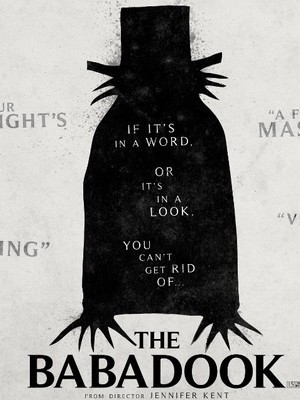
This might be my favorite on the entire list, so I'm gonna stick it right here at the top. But really, if there's one movie on this list that you should watch, it's the Babadook. Sure, you might have to suspend your disbelief on a few occasions, but it's totally worth it. It seems so rare that horror movies transcend their linear plots into something deeper, but the Babadook succeeds to descend to wonderfully cerebral depths. Without spoiling too much, the plot centers around a mother, grieving the loss of her husband, and her ADHD trouble-child, who come across a creepy kids’ book. An emotional and psychological haunting ensues that dares viewers to venture into the realms of depression and mania.
Let the Right One In - 2008 [TRAILER]
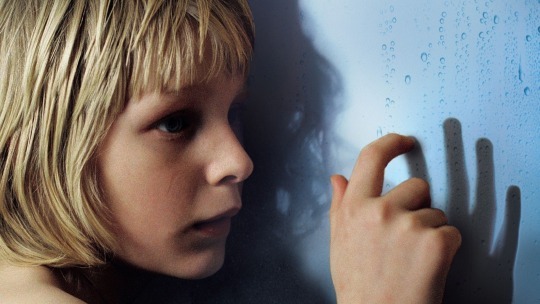
I've been bored of Vampires since Harry Potter, but this little charmer bit me right in the jugular. The plot centers around a boy who befriends a young female vampire—and yes, for you vampire loving people out there, it does get kind of romancy (in that innocent kid way). Apart from the totally on-point acting, the film maintains an oddly delicate balance of emotional tenderness and intimacy to total blood-chugging brutality. It is easily the best vampire movie to date, and if Swedish subs aren't your thing, there's an American version, Let Me In, that is equally as good.
It Follows - 2015 [TRAILER]

With one of the most original plots I've ever experienced in a horror movie, It Follows is being touted as one of the best movies of 2015. It's a film best left to experience without outside influence, but I can say that this film will be well enjoyed by those who appreciate speculation, interpretation, and subplots involving the exchange of STDs. It follows tread along a straight forward plot, but contains a wonderful amount of depth to sift through afterward. The film also has top-notch acting and is beautifully shot (much of it shot in Detroit). Make sure you see it with a few friends so you can talk about it afterward!
The Orphanage - 2007 [TRAILER]
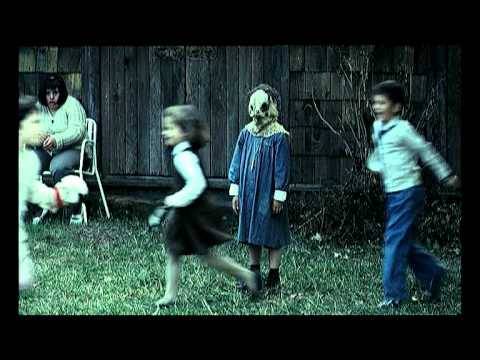
I love me a sad, creepy ghost story, and there's something even better about them when they involve dead children. Like many of the films on my list, The Orphanage, produced by Guillermo Del Toro, has just that. But in all seriousness, this film has a wonderfully emotional story that’s rarely found in the horror genre. It's a well-known classic amid fans of the horror genre, a film that masterfully builds writhing tension to evoke its scares.
Lake Mungo - 2008 [TRAILER]

Lake Mungo offers a long-winded but mature examination of loss and grief. Its presentation is almost dreamlike, with a plot that focuses on the horrors experienced by a family after the drowning of their daughter. Lake Mungo exceeds as a film in the way that it relentlessly builds upon a wrenching sense of dread. Made with a tiny budget, but supported by solid acting, this film is surprisingly believable and captures the vulnerability, isolation, and confusion experienced after the unexpected death of a loved one. Simply put, this movie is completely terrifying, yet contains almost no cheap scares. It's a 100% unrelenting, slow-roast dread that doesn't let up until well after the credits.
REC - 2007 [TRAILER]

The original REC is a deliberately fast-paced film that sandwiches its doomed characters between compounding layers of dread, resulting in of one of the best modern horror films in years. The pseudo-zombie plot derails right from the get-go, and later smashes into the supernatural for a terrifying climax. But the disgusting monster at the end? That takes the cake for one of nastiest creepers ever to make it into cinema.
The Curse (Noroi) - 2005 [TRAILER]

There is a goldmine of Eastern horror out there, and the Curse represents the genre as one of the best. It's a Japanese, low budget, faux documentary, that—amid scenes of complete ridiculousness—manages to be completely and dreadfully effective. Noroi presents an engrossing, slow-burn mystery that carefully leaks the details of an ancient demon-curse. If you're interested in venturing into classic eastern horror, definitely check this one out.
Kill List - 2011 [TRAILER]

In some ways, Kill List tries to be a deep character study (and I'd say for the first 45 minutes, this might hold true), but then it’s quickly upstaged by an eerie crime drama, which later transforms into a totally effed cult-terror-gore-fest. Somehow, it all seems to work together, leaving you with a disturbing, yet surprisingly thought-provoking mess to discuss with your friends. This is a film to be viewed with others, and I highly recommend it for those who love cults, mysteries, and gore.
28 Days Later - 2002 [TRAILER]

While I wanted to avoid the obvious choices for this list, I couldn't leave out 28 Days Later, because...Well, it's just too good to ignore. With fast zombies, sympathetic characters, and incredible production, Danny Boyle has created one of the best pieces of apocalyptic horror ever made. You’ve probably already seen it, so you might as well see it again.
The Descent - 2005 [TRAILER]

The Descent stars six women, all part of an extreme adventure club, who decide to explore the creepiest cave in the entire world. In this cave, of course, dwell terrible, fanged, amphibious slime creatures who have an affinity for jump scares and standing directly behind the backs of the characters...but the real horror of this movie is the cave. The movie absolutely excels in conveying intense desperation and suffocating claustrophobia. Despite solid reviews, I had low hopes for this movie, but ended up really enjoying it. Highly recommended.
Cabin in the Woods - 2012 [TRAILER]

Horror fans tout Cabin in the Woods as a modern classic. Is it particularly scary? No. But it does provide an ample serving of self-aware humor and cliche-bending twists. I don't care much for self-aware horror movies, but Cabin in the Woods does it right, offering one of the best works of pop culture entertainment that the horror genre has ever seen.
Suicide Club - 2002 [TRAILER]

With an opening scene of 50+ Japanese schoolgirls jumping in front of a train, I can confidently say that Suicide Club is one of the most hardcore horror movies of all time. The movie follows a wave of unexplained suicides and slowly pieces together a rather nebulous mystery. Answers, however, are few and far between, and I am still not sure if I actually like this movie. But for anyone who is looking for something a little bit darker, this is for you.
Battle Royale - 2000 [TRAILER]
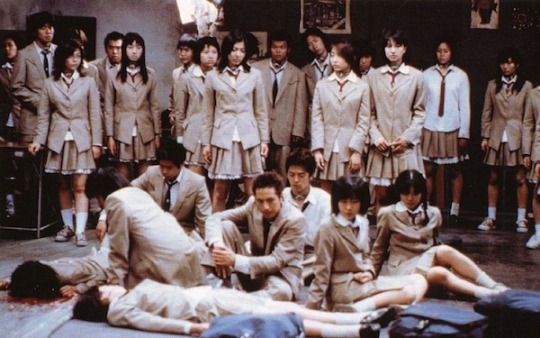
Before the Hunger Games, there was Battle Royale, which happens to be set in a similar dystopian universe, wrought with unemployment, crime, and malcontent. Each year, a randomly selected 9th grade class of Japanese, khaki-donning schoolchildren are outfitted with exploding shock collars and given an assortment of weapons. They are then forced to hunt each other down until there is only one left. Long story short, it's the hunger games with an R rating, and if I am not mistaken, this controversial child-massacre-gore fest was banned for a time. But for real, this movie rules, topping its big-budget, modern successor with tons of style, as well as a healthy dose of dark, humorous cynicism. If you felt that the Hunger Games didn’t have enough teen gore, then this movie is for you.
The Devil’s Backbone - 2001 [TRAILER]

A haunting allegory of the Spanish Civil War, Guillermo Del Toro's film presents a chilling school house ghost story that stands as a masterfully produced piece of cinema. It's heavily atmospheric, emotionally fraught, and above all else, spooky. This fable is one of Del Toro's best and is a must watch on this list.
Creep - 2015 [TRAILER]

Laced in dry humor, Creep is another slow burner that masterfully builds upon a foundation of discomfort and creeping uneasiness that relies little on jump scares (although, it does not forgo them). The two fold script prompts some of the best acting on this list - and rumors state that much of it was improvised. Creep is proof that you don't need to have a big budget with CGI jump scares to make a compelling horror movie. Did I mention that it's available for Netflix streaming, too?
Gerald's Game (89% RT) [TRAILER]

The plot begins with a dude named Gerald, who, with his wife, depart to an ocean side cabin for a sexy-time retreat. Except their sexy time, in typical Stephen King fashion, goes horribly wrong. Next thing you know, Gerald is being eaten by a dog and she's handcuffed to the bed and then the boogieman starts to come out at night. Hopefully I didn't just ruin the movie for you, but for real, it gets really good - and the boogieman is one of the best horror spooks I've seen in a long time. The wife, Carla Gugino, gives nothing short of a stellar performance, too.
The Witch (91% RT) [TRAILER]
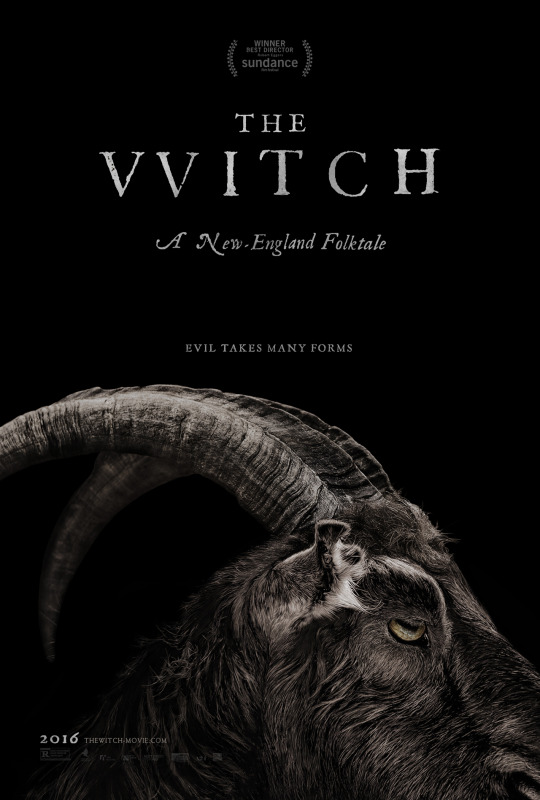
The Witch centers itself around a (Puritan?) family who is banished to the outskirts of the New England wilderness in the 1600s (where an ancient and foreboding evil lurks). Shortly after, the crops die, people get possessed, someone's nipple is eaten by a demon crow, and Satan appears as the family goat, named "Black Philip." Despite what I just said, the Witch bares little, but what it does reveal is absolutely brutal. But the real horror is not what hides in the woods, but rather the evil that makes its way inside of the characters. Overall, it's an exceptionally well made period piece that will marinade you in dread... and thus the Witch is one of my favorite horror movies of all time.
Under the Shadow (99%) [TRAILER]

Under the Shadow is an art house masterpiece that serves as one of the greatest horror movies ever made, yet it is mostly unknown outside of horror circles. The movie is about an Iranian mother and daughter, living in a bombed out Tehran in the middle of the Iran-Iraq war. Her Husband, a doctor, is drafted to serve at the war front and they are left behind when an undetonated missile comes crashing into their apartment building (followed by a superstitious neighbor spouting about how the missile brought with it a middle eastern demon, or Djinn). Things start to get creepy when random items being to go missing, the daughter's behavior becomes increasingly erratic, and the Mother is plagued by horrible nightmares. But most unnerving of all is the isolation and desperation of a mother and daughter trapped in urban chaos.
IT (86% RT) [TRAILER]
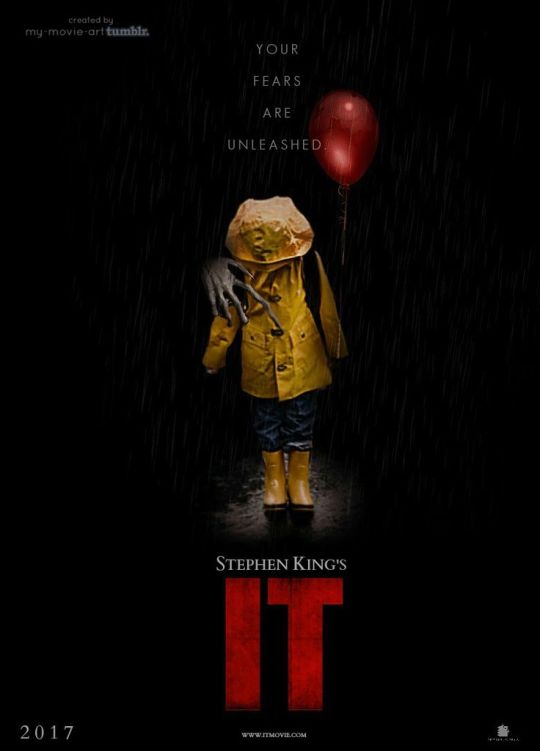
An ancient, child devouring evil lurks under the town of Derry, Maine, who manifests itself physically as the apex of one's fears. Over the centuries, It has developed a taste for children (whose fears are easier to conceptualize, apparently), and thus It's preferred manifestation is that of a google-eyed, drooling, and mildly pedaphilic clown named Pennywise. Without drenching this write-up with my slobbering love for this movie, please know that the director and actors absolutely nailed it. The book presents 1200+ pages of historical world building with time-jumping plot lines - and the movie does an amazing job portraying the phantasmagoric and fantastical, yet demon-beleaguered town of Derry. Director, Andres Muschietti and co. deserve every penny of the 300 million dollars it has grossed since release.
It Comes at Night (89% RT) [TRAILER]

It Comes at Night is a psychological slow-burner, relying on the fears of the unknown, of mistrust, and of post-apocalyptic desperation. The plot revolves around the plight of a family, isolated and hidden, in their forest home as an undefined and unnatural blight ravages the outside world. One day, another destitute family comes stumbling into their home, who are cautiously taken in. Paranoia and mistrust slowly begin to boil between the two families, awakening an evil greater than the zombie-esque disease they seek to hide from. It's an unnervingly fantastic film that will stick with you long after viewing.
Get Out (99%) [TRAILER]
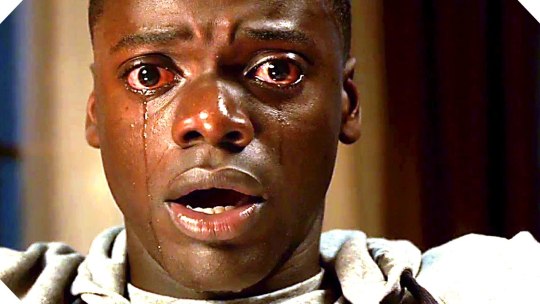
You can't have a “best of horror” list without mentioning "Get Out." The plot, which involves a bi-racial couple making a visit to the girlfriend's (white) parent's house, is both sharp and nimble in its often satirical portrayal of racial tension. The over-the-top plot initially focuses on a particularly awkward form of racial envy, which quickly derails into something much more sadistic - all the while tinged with director Jordan Peele's trademark humor. It is a movie that gives hope to the genre and has absolutely cemented itself as one of the best horror flicks ever made.
Train the Busan (95%) [TRAILER]

A father and daughter find themselves fleeing through the countryside (via train) amidst a zombie apocalypse. It's predictable, gory, and over-the-top, but in our cinematic world, over-peppered with every kind of zombie flick conceivable, Train to Busan still explores nuances amidst its campy and relentless action. Simply put, "Train to Busan" is a well-made and exceptionally entertaining film that still offers a dose of originality from within its South Korean setting. Just try not to take it too seriously.
The Wailing (99%) [TRAILER]
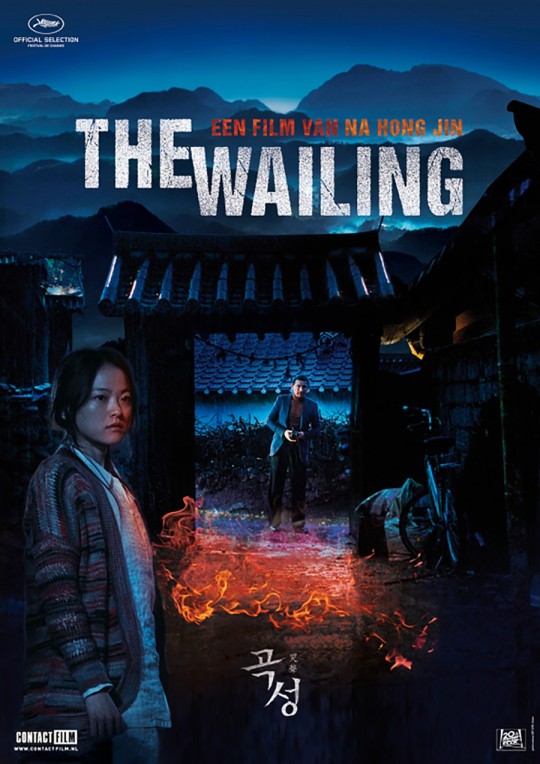
In a quiet south Korean village, a strange visitor appears, and soon after people start violently killing each other. In a panicked desperation, the police consult the occult to aid in solving the mythical blight that threats to spread beyond the village's outskirts. The Wailing is best enjoyed without knowing too much, but this phantasmagoric and gritty film is a cemented gem of Korean horror. It has some flaws and is exceptionally long, but the exploration of creepy eastern cult-mythology makes it well worth the trek.
The Banshee Chapter (75% RT) [TRAILER]
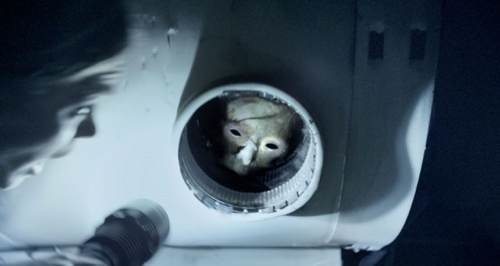
A man goes missing after consuming some CIA branded psychedelic research chemicals - and his friend decides (with the help of a gonzo-inspired journalist) that she’s going to track him down. They acquire the aforementioned chemicals and proceed to smoke them, which apparently allows an evil deity to invade their lives (this particular deity takes the spooky meter and sends it to level 10). The plot is, admittedly, pretty lame, but if you can embrace the campiness, you'll find the movie is legitimately terrifying. I was prepared for a b-movie cheese fest, but for real, this movie is exceptionally spooky.
Hell House (76%) [TRAILER]

A malfunction occurs in an Halloween attraction set on the site of a hotel with a nefarious past, causing the death of 15 people. A half decade later, a documentary crew decides to investigate the tragedy and end up acquiring some tapes of the incident. It's a bit cheesy, but the plot and the acting are pretty damn good for a straight-to-VOD, found footage B-movie. Most importantly, though, is that "Hell House" is extraordinary creepy; completely worth watching for the thrill of horror.
Hereditary (89% RT) [TRAILER]

Cemented by Toni Collette’s wonderful performance, Hereditary is easily the best horror movie of 2018. The movie presents one menacing sucker punch after another as it rips apart the ground beneath the security of home. Both devastating and anything-but-subtle, Hereditary is recommended to those who like ancient demons, candle lit seances, and the occult.
A Quiet Place (95% RT) [TRAILER]
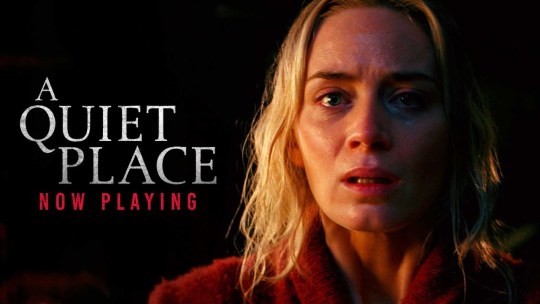
A Quiet Place’s plot, both affecting and inventive, throbs with (at times) agonizing, hold-your-breath tension. At the core you will find a family of four, struggling to survive in a world inhabited by invasive, sound-sensitive creatures who would prefer the extinction of humans. John Krasinski serves as both director and acting lead, which is good news for those of us who could care less for the recent stream of superfluous action movies he’s been producing.
A Dark Song (91% RT) [TRAILER]
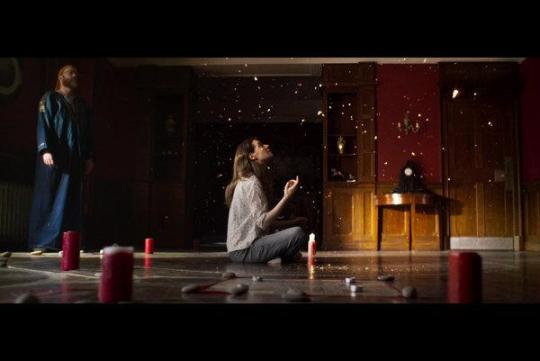
Brooding and methodical, A Dark Song is set-piece pagan horror at its finest. It features only two characters: A mother in mourning and an arrogant occultist whom she seeks the aid of. The duo lock themselves in an old mansion to enact a lengthy and risky ritual, one that (ideally) results in a wish being granted. The acting is both fantastic and believable as the characters, in typical horror movie fashion, make mistakes that send them into a descent of madness. It’s witchcraft-gone-wrong; a slow burner with the relentless dread and chaos of a waking nightmare. This is one of my all time favorite indie horror movies. Highly recommended.
1922 (89% RT) [TRAILER]

Unreliably narrated via the confession of a father who murders his wife (and who also ropes his hesitant son into the act), 1922 is a brooding tale of a man driven to madness by way of guilt. There are no jump scares to be found, as the movie favors the father’s slow-rot suffering and his futile and increasingly desperate attempts to bury his festering guilt. Psychological horror at its finest, this King adaptation is another excellent addition to Netflix’s diverse and original collection of horror movies.
The Ritual (71%) [TRAILER]
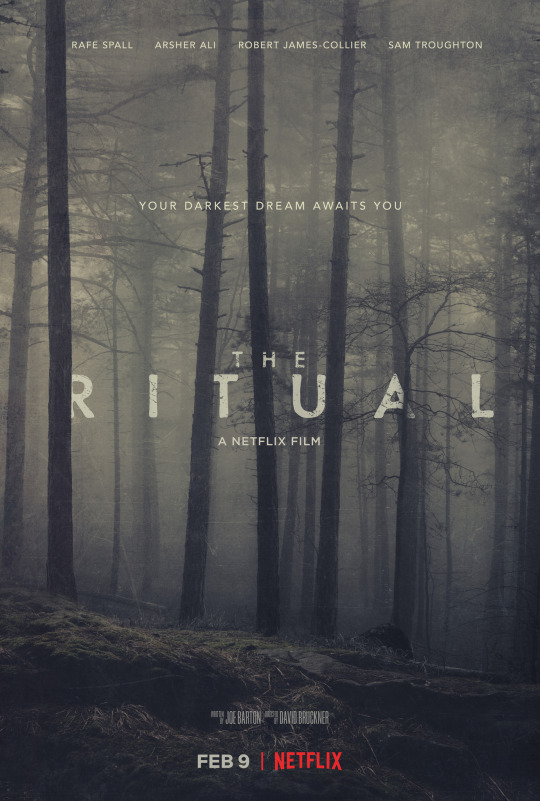
While imperfect at best, this B-movie, set in northern Sweden, provides an interesting set (creepy, frost-dusted hinterlands) inhabited by four bros and an imaginative monster who’d prefer they were hiking somewhere else. Ankles are sprained and tempers swell as the friends become increasingly lost amidst a forest of their misjudgment. This movie is the definition of “pretty decent” with enough substance to hopefully see you through to the “less than decent” finale.
6 notes
·
View notes
Text
The Vindication of Venom Part 5: A Monstrous Mystery
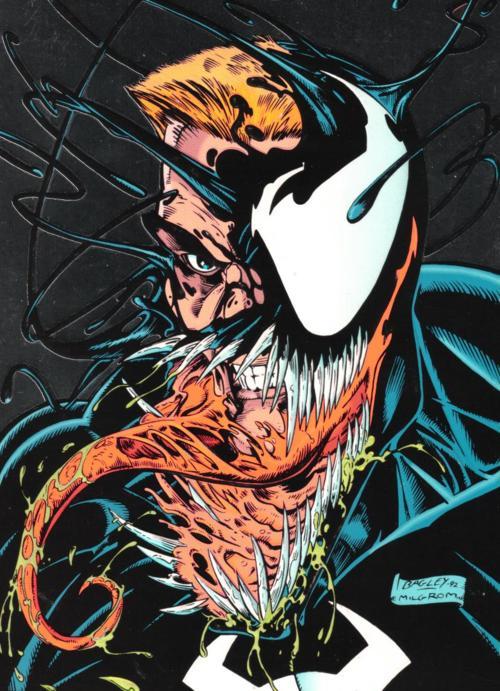
Part 4
Part 6
In the last few parts I laid out how fans’ expectations for Venom were at odds with his original concept as a stalker villain.
Keeping the idea of Venom as a stalker in mind I’m going to dive into addressing other criticisms levelled at the character’s origins.
To begin with I’ll tackle allegations that ASM #300 and the reveal of Brock’s identity was a poor resolution to the mystery of Spidey’s stalker.
Back at the start of this essay series I noted (among other things) two particular criticisms levelled at Venom’s origin:
· Brock was a previously unknown character who is unconnected to Peter Parker’s life in or out of his costume.
· The reveal of Brock as Venom is a bad resolution to the mystery story seeded in issues leading to ASM #300
In Parts 3-4 I also discussed about the dissonance between the creative intentions of David Michelinie vs. the fan expectations for Venom.
It is my belief that understanding those expectations compared to the original intentions is the key to understanding the reveal of Venom’s identity.
To be direct I think the fans following ASM (and possibly Web) believed that they were reading a mystery story when in fact David Michelinie had never intended to make Venom’s identity a legitimate mystery, and arguably never wrote a mystery story surrounding his identity on the first place. At the same time I think the decision to make Venom an unknown character was a very deliberate decision.
All of which can be understood when observed through the lens of Venom as a stalker and a closer look at the issues leading up to ASM #300.
To begin with we have to recognize that David Michelinie is a writer who has stated he typically plans his stories well in advance. There is numerous evidence for this, but two particular examples come to mind.
Back when he’d hoped to stay on ASM and write Amazing Spider-Man #400 he’d intended for the issue to be the death of Eddie Brock, bookending the fact that the character truly debuted in ASM #300. He intended this even though his last issue of the series was ASM #388 published roughly one year before ASM #400 would’ve dropped.
In Amazing Spider-Man #344 published in 1991 we first meet Cletus Kasady, and in the very next issue we see a tiny piece of Venom’s symbiote start to drip onto his hand.
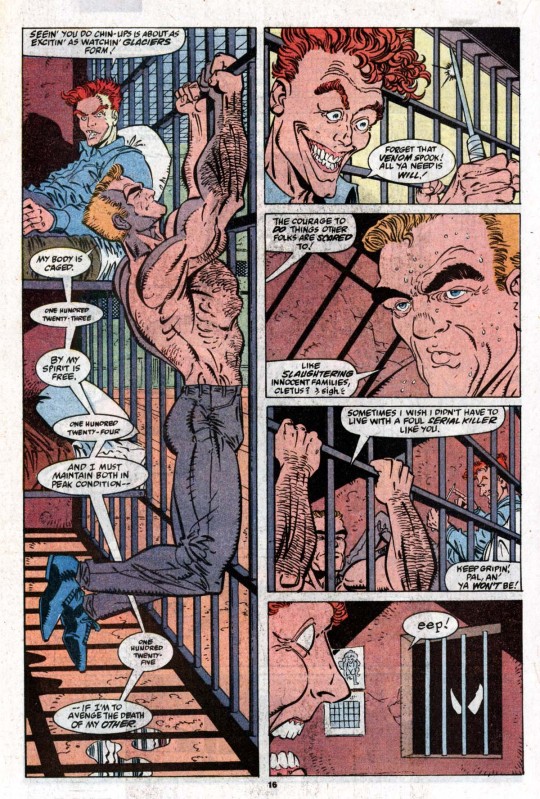


This was all set up for Amazing Spider-Man #361 (published in 1992) where Spidey faces off against Carnage, though the character had appeared in a subplot beginning in ASM #359. Either way Michelinie had planned for Carnage at least a year in advance and properly laid the groundwork for the character during that time.




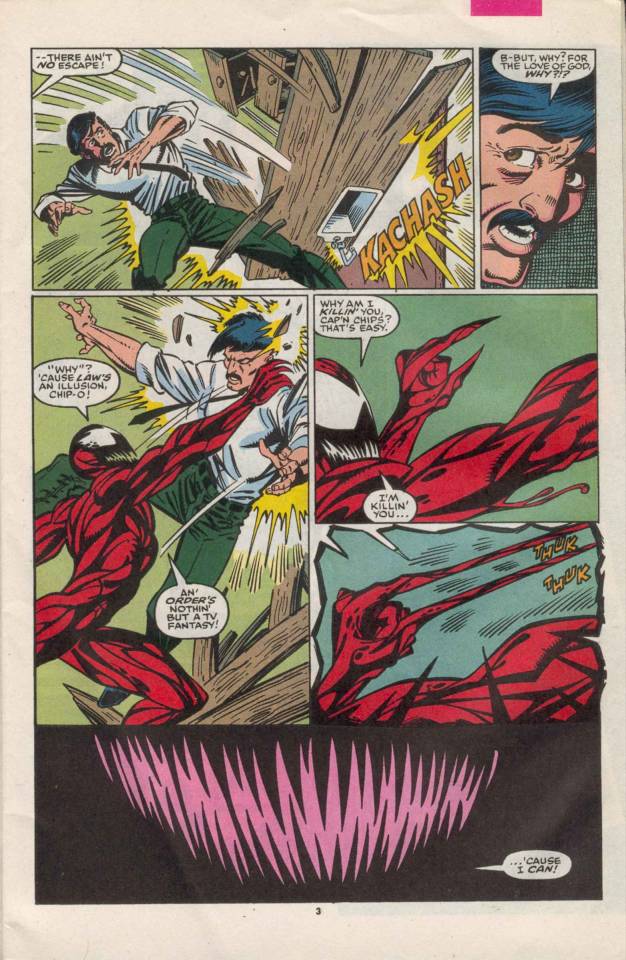
In examining Venom’s debut Michelinie similarly had a lot of time to plan ahead, well over a year in fact.
ASM #298 came out in 1988 whilst Web of Spider-Man #18 hit the stands in 1986, Michelinie obviously having planned out Venom in advance of the latter issue. Michelinie then had four more consecutive issues of Web, one of which (as we’ve seen) further seeded Venom, keeping his identity obscured. Michelinie then wrote five ASM issues and an annual before the publication of ASM #298, all of which could’ve been used to at least hint at Eddie Brock, even if he was just a background character.
I do not know what was happening behind the scenes at that point but it’d seem unlikely that there was just no time to set Venom up before he debuted. Furthermore no statements by Michelinie or any other reliable source I know of has ever indicated a character Michelinie had in mind for Venom’s identity other than Brock or his early nameless female counterpart.
Together these facts heavily indicate that rather than merely executing a mystery story incompetently (as has usually been the criticism) Michelinie never intended for Venom’s identity to have ever been the subject of a true mystery story and for Venom to have genuinely been a never before seen character.
This is backed up when you consider that in most mystery stories suspects, clues and potential answers are given to the readers ahead of time to increase suspense and tease the possible resolution. Michelinie even did this with the infamous storyline surrounding Peter Parker’s returned parents even though its originator, then spider editor Danny Fingeroth, never pinned down the endgame of that storyline.
And yet between Web #18 and ASM #300 at no point was there ever even a tease or a hint as to who precisely Venom might be. We simply had a mysterious stalker in two Web issues, then over a year later another tease of someone who had the symbiote and then two more issues later we got the full Monty.
Structurally that isn’t really a mystery storyline but it does superficially look like one to many readers. After all if someone unseen is attacking and stalking Spider-Man then naturally readers will wonder who it is and expect it to be someone they know or will come to know. No doubt this was the subject of letters Michelinie and editorial received and yet the storyline unfolded with no clues and complete unknown unveiled as the culprit.
Furthermore when Venom’s identity is finally revealed in ASM #300 it is done without much fanfare and is for the readers exclusively. Typically you would expect the readers to learn the mystery man’s identity alongside the titular character, but here we not only see who he is sans Spider-Man’s presence but the reveal is not presented as a moment of true shock or impact, which again is mystery writing 101.

After this initial reveal we even follow this unknown and unnamed individual as he continues to stalk Spider-Man and plot against him.

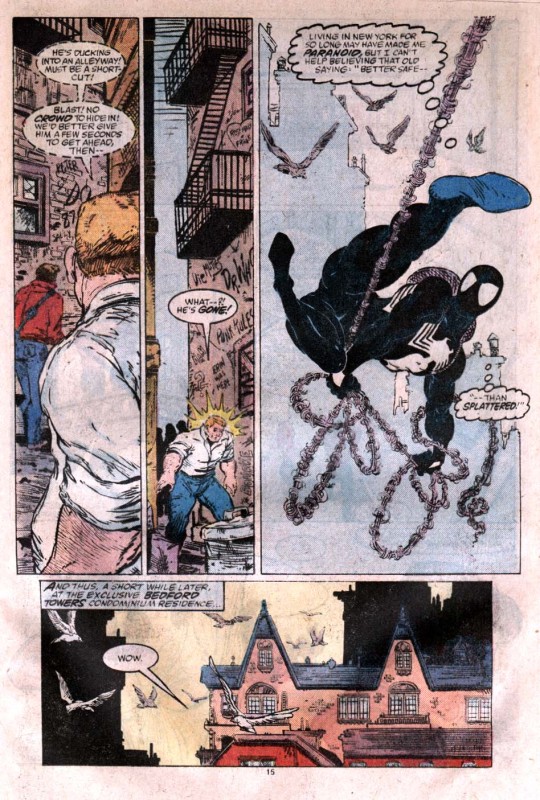


Whilst these scenes might shed more light onto the type of person the symbiote’s new host is, they are just outright illogical as mystery story writing and further devalue the impact of the character’s identity, especially since we don’t even know his name at these points in the issue.
In fact when we do learn his name the story presents itself as the true blue introduction to the character, going on to give a potted biography of Brock.

Presenting the character this way and divulging this information really doesn’t make sense so many pages after we first see the character. Unless as I’ve said, we were never really reading a mystery story to begin with and Brock was deliberately intended to be a stranger from the start.
Now you might ask why on Earth would Michelinie want something so unsatisfying as part of his on-going storyline? Wouldn’t it be much more dramatic for Venom to have indeed been revealed as someone from Peter’s life, or at least someone the readers were familiar with? For example over the years a suggested substitute for Venom’s identity has been Peter’s photographic rival at the Daily Bugle Lance Bannon (who possibly inspired Spider-Man 3’s version of Brock).
Well to begin with we should put ASM #300 in context. It was released less than a year after the highly controversial resolution to the Hobgoblin mystery in ASM #289. The issue wrapped up four years worth of mystery and intrigue surrounding the highly popular new villain the Hobgoblin, ultimately revealing him to be Bugle reporter (and sometimes rival to Peter) Ned Leeds.
The resolution was divisive for fans, some feeling the resolution was too predictable, others feeling it made sense but was unsatisfying since there was no showdown between the Goblin and Spidey. The mystery had begun under Roger Stern’s iconic run on Amazing Spider-Man and had continued for around four years, through more than one staff changeover in the Spider-Man office. In fact the resolution of the mystery was the subject of much contention and internal disagreements between certain individuals working in the Spider-Man books during that time.
In such a context it is not unreasonable that Michelinie and then editor Jim Salicrup felt that it’d be a mistake to emphasise yet another mystery villain plotline so soon (or at least for any significant length of time), mostly because it would’ve been far too repetitive or risked backlash from the readers.
However more poignantly Venom being an unknown individual makes a lot of sense in light of his original intentions as a stalker.
Realistically whenever Spider-Man uncovers someone’s true identity it is unlikely that he would know who they are given just how many people live in New York city, let alone its frequent visits by aliens, mystical entities or other such beings. This is something even acknowledged in the original Stan Lee/Steve Ditko run of Spider-Man on more than one occasion.


But for Venom as I’ve detailed Michelinie’s intent was to play him more as a super villain celebrity stalker, much like Mary Jane’s numerous stalkers from later in his run (e.g. Jonathan Caesar).
Such celebrities seldom know who their stalkers are and usually their stalkers are just random people off the street with an obsession and/or major beef with their intended victims, the latter often over an imagined slight or otherwise not warranting their behaviour. For Spider-Man in particular this would be particularly true given the countless people he’s interacted with other the years, the various instances of collateral damage he’s been a part of and the sheer number of enemies he has acquired from his years as a crime fighter.
In being a stranger to the readers, Brock emphasises the constant presence of danger in Spider-Man’s life and his need for a secret identity. He showed the readers that Spider-Man doesn’t endure potential risk just from criminals and super villains, but also from other unknown seemingly ordinary people just off the street with tangential (even illogical) axes to grind against him. In fact the anonymity and unfamiliarity of Venom could be said to render him a more disturbing stalker figure in Spider-Man’s life.
He isn’t an old enemy with an axe to grind. He isn’t even a friend of family member of someone Spider-Man has defeated out for revenge. He is just some guy Spider-Man has never met who’s life went to Hell because of Spider-Man inadvertent actions, or rather that’s how he sees it. The inadvertent aspect of the story is further enforced through tying venom’s origin into an established event the readers would be familiar with, highlighting unintended consequences of Spidey’s actions that he, and by extension the readers, wouldn’t normally think about.
This core concept was present in Michelinie’s original female rendition of the character as well. Both that and the eventual origin we got were playing upon the idea of unintended consequences of innocuous actions on Spider-Man’s part, where someone gets hurt through no fault of Spidey’s but due to their own issues makes him the object of their hatred.
Now there is a problem with this line of argument that I have to admit to. In ASM #300 itself (as you can see above) Peter does in fact recognize Brock. This does unfortunately damage the idea of him being a true unknown to Peter and the readers.
More than anything in ASM #300, this I think is the biggest legitimate case of weak or misguided writing on Michelinie’s part. I maintain that he absolutely wanted Brock to be an unknown character from the start and have that be part of the central point of the character.
For years I was at a loss as to why this scene played out the way it did...until I actually asked David Michelinie himself. Bear in mind that I chose my words carefully so as to be polite and thus increase my chances of a response:
ME: Mr Michelinie early on in Amazing Spider-Man #300 we first see Venom’s true face but don’t get his name or motives.
We then see his actions during the issue which lead to a pivotal scene in which he reveals his face to Spider-Man. Spidey then reacts in shock since he recognizes the face and readers learn Venom’s real name is Eddie Brock, followed by his origin.
To me personally the scene seems intended as a shocking reveal, sort of like when the Green Goblin was finally revealed to be Norman Osborn back in Stan Lee and John Romita’s run.
However the readers had never heard of Brock before ASM #300 so the ‘shock’ and reveal in the scene to me seems a little odd.
With this in mind I would like to please ask why you opted to play the scene in this way, specifically why you opted to have Spider-Man know who Brock was despite the readers being unaware of who he was.
It’s just something I’ve always been curious about.
DAVID MICHELINIE: Actually...that was never intended to be a shocking reveal–to the READERS. But then, I wasn’t writing the readers, I was writing Peter Parker. He was surprised because he was aware of Eddie Brock as a fellow journalist, as indicated by Spider-Man’s thought balloon (“Looks familiar! Like–”) followed by Brock’s dialogue (“Ah, you’ve seen my picture in the Daily Globe!”). At which point both Peter AND the readers know Brock’s/Venom’s identity, learning at the same time. Eddie then goes on to explain–to everyone–how he and the alien symbiote became one. It’s just the way the story was structured.
This somewhat resolves and one of the major criticisms of ASM #300.
That big shocking reveal moment which doesn’t make sense because Brock isn’t known to the readers is not in fact supposed to be a big shocking moment, but a dramatic set up for an introduction.
And Spider-Man’s reaction is present because having worked out Brock’s backstory Michelinie evidently felt it’d be unrealistic for Spider-Man to not recognize him as a fellow journalist. This does make quite a bit of sense given Brock’s alleged reputation as a high profile journalist for a major metropolitan newspaper and peter himself moving in journalistic circles thanks to his work at the Bugle. In fact (even putting aside Brock’s fame from the Sin Eater articles) given how Brock’s newspaper the Daily Globe was the Daily Bugle’s main rival and that in-universe it hadn’t been too many years since Peter himself worked at the Daily Globe it probably would have been unrealistic for Peter to not recognize him.
However whilst realistic and absolutely making sense from the perspective of Spider-Man the scene is an example (perhaps the prime example) of how Venom’s character was not communicated as well as he could have been.
The scene, especially when taken in isolation, absolutely plays as the culmination of the ‘mystery’, the big reveal moment, but it was never meant to be that. Maybe it’s the particular dialogue used, the pacing employed, even the angles and layouts of the art, but it all comes across in a manner which would make sense in a different type of story than what is intended. Had it been tweaked it would have sold the central idea in such a way that readers would’ve realized that this is a moment of shock intended for Spider-Man, not for them.
However given the scene was intended as an introduction to a new character and the obvious stalker coding of the character I think at the end of the day Michelinie should’ve put his faith in a certain suspension of disbelief on the part of the readers and simply had Spider-Man not know Brock’s identity, all of which would have better communicated the stalker idea of the character, the notion of unintended consequences and the fact that Spidey has enemies who’re complete strangers to him.
What’s ironic is that based upon what we know had Venom been the original female version of the character it is unlikely that the scene would have played out the way it did. It is also ironic that the scene has generated so much controversy and haunted the character ever since due to Michelinie being too realistic.
Nevertheless it should be noted that whilst Peter does recognize Brock, his recognition only stretches as far as knowing his name and face. This therefore doesn’t entirely invalidate the idea of Brock being an unknown stranger who is nevertheless a dangerous enemy to Spidey.
Next up we’re going to talk about the notorious retcons present in Brock’s origin in relation to the iconic Death of Jean DeWolff storyline…and question if they are as contradictory as many readers think.
P.S. An often tangential complaint of Brock being an unknown character is that he was unworthy to know Spider-Man’s identity, especially when a major and well-established enemy like Doctor Octopus didn’t.
But really it is actually all too appropriate for Brock to know his identity whilst being a stranger to Peter and the readers. As I’ve discussed above, it just re-emphasises the importance of Peter’s secret identity and how he has even unknown enemies posing a risk to his life. It showcases the dangers of one of his enemies knowing who he is just as Norman Osborn knowing in the Silver Age did, but it comes at it from a different angle.
Part 4
Part 6
#Venom#eddie brock#marvel#marvel comics#spider-man#peter parker#David Michelinie#Jim Salicrup#Peter David#Ned Leeds#Hobgoblin#the hobgoblin#Electro#Steve Ditko#Max dillon#crime master#The Vindication of Venom
14 notes
·
View notes
Link
NEARLY A MONTH after her firing from the White House, Omarosa Manigault Newman appeared on Celebrity Big Brother to embark on a “total Trump detox.” In the two and a half weeks she was on the CBS spinoff show, the former reality TV star discussed her time working for President Trump, a man she once considered a friend, mentor, and fellow trafficker in showmanship.
She recounted being “haunted by [his] tweets every single day,” insisted Vice President Mike Pence was the person to keep an eye on, and claimed she joined the Trump Administration because she “felt like she was serving [her] country, not him.”
But Omarosa’s tell-all Unhinged: An Insider’s Account of the Trump White House offers less patriotic reasons for her decision to join the “Trump Train” in July 2016. She writes that the former businessman “had asked [her] to support” his presidential campaign, an offer she couldn’t refuse because of the gratitude she felt toward him for casting her on the NBC reality TV show, The Apprentice, in 2003. The relationship, she says, was “symbiotic.” When the first season premiered, it launched both of their careers as national shock jocks, eager to secure high ratings at any cost on the reality TV circuit. With his reputation as a straight-talking “real estate maverick” from New York, and her status as an eccentric villain who could get him “attention and headlines,” the duo, with the guidance of reality TV producer Mark Burnett, helped Donald Trump go from being a failed real-estate mogul representing the worst of the ’80s, to a legitimate businessman equipped with marketable catchphrases and a brazen charisma which would later capture the hearts of American voters.
When she lays out her journey from the Westlake projects in Youngstown, Ohio, to college, the Clinton White House, reality television, and finally the Trump White House, you can’t help but marvel at the sheer variety of her life experiences, and her relentless determination to realize the “American Dream” on her own terms. While the idea of achieving immense wealth through sweat and grit is possibly the most harmful of America’s founding lies, it doesn’t stop Omarosa from talking about her hardships with bootstraps language. It’s both an extraordinary and gloomy testament to what marginalized people are forced to survive, notwithstanding depression, poverty, and prejudice.
Grief takes center stage in several passages of Unhinged. In Omarosa’s world, mourning is messy, compassionate, callous, selfish, and self-serving. At her brother’s funeral in October 2011, she writes that the National Enquirer sent a black woman journalist to pose as a griever, only for her to take Omarosa’s eulogy, and present it as a reported article. It’s an immoral stunt which Omarosa acknowledges and responds to with a lawsuit against the tabloid. The only problem was David Pecker, the owner of the National Enquirer, had a cozy relationship with her then-former boss, Donald Trump. In a move that could only exist in Trump-Omarosaland, the self-styled mogul negotiates for his protégé to be the West Coast editor of the tabloid, in exchange for the lawsuit being dropped. What would seem an unforgivable breach of trust to most becomes another business deal for Trump, and a résumé-builder for Omarosa.
Before The Apprentice began shooting in the fall of 2003, Omarosa states that she read “every Trump magazine profile and interview,” and watched “videos of his TV interviews” with the purpose of turning herself into “a female version of him.” She uses the same disciplined mimicry in Unhinged, parroting the playground insults both used by and lobbed against her former boss. She calls the president “Twitter Fingers,” brings up his obsession with daily tanning sessions, and decides his love of “Big Macs and fried chicken” have left him “obviously obese.” She also alludes to the diagnoses made about Trump’s mental health by professionals and non-professionals alike, often highlighting her concern for his sanity.
These remarks may be truthful and humorous to some, depending on how many times you can laugh at “orange-in-chief” or “cheeto dust” appearing on your timeline. But they don’t present the reader with the sort of confidential information you’d assume close proximity to the most powerful man in the world would yield. For all Omarosa’s methodical scheming, her attempts to solicit support from the same liberal media she was more than happy to antagonize are sloppy and desperate. After finding herself exiled from Trumplandia, she appears to be on a mission to find a sympathetic ear she can use for her elaborate public redemption.
When Omarosa writes that the discovery of the alleged N-word tape would be the “last straw” for her, you feel insulted at how brazenly she’s willing to undermine the reader’s intelligence to salvage her own image. By the time she claims to have heard the tape, there’s been too much said and done for her to pretend that Trump’s bigotry was her “blind spot.” She’s also proven that she doesn’t mind leveraging her unique relationship with the commander-in-chief to rebuff evidence of his prejudice. When six alumni of color from The Apprentice speak out against the then-presidential hopeful right before the New York primaries, she goes on the offensive. She books several interviews on cable news channels, writing that her “strategy was to say how much Trump had supported” her. So in other words, he had black friends. This just goes to show that if there’s anything Omarosa knows how to invoke or minimize when it’s convenient for her, it’s race.
Omarosa isn’t convincing anyone of her supposed naïveté and ignorance about Trump’s racism either. We find her stumbling her way through a litany of Trump’s “racially charged” offenses, some of which include birthing the birther movement, pitting races against each other on The Apprentice, referring to Haiti as a “shithole country,” hiring both Steve Bannon and Jeff Sessions, calling Mexicans “drug dealers” and “rapists,” and claiming there were “fine people on both sides” in the wake of Charlottesville. She gives racism an array of spicy euphemisms like “provocative,” “inflammatory,” “controversial,” and “inappropriate,” sometimes preferring its academic, elegant cousin, “racial,” when Trump’s remarks veer too far even from the type of prejudice white people can tolerate from drunk relatives during the holidays.
When she does go into detail about her day-to-day activities at the White House, she can’t resist portraying herself as a humble servant of the American people, looking to advance “diversity” in a government adored by the likes of Klu Klux Klan grand wizard David Duke. There’s no question Omarosa took her position in the administration seriously, a reflection of her own self-seriousness to be sure, but this account doesn’t seem like an honest recollection of what she actually did on the job. If she’s not telling inflated tales about putting out fires, she’s either anticipating or creating them. And when she mentions being worried about Trump’s ability to process complex information, or the establishment vultures encircling the Oval Office, it doesn’t conjure up any of the shock or concern she seems to want from the reader. Perhaps these statements are so in line with what we expect from the Trump administration, we can only greet Omarosa’s list of complaints with an eye roll and a told-you-so.
In the prologue and epilogue, she goes back to her unceremonious sacking by Trump’s chief of staff, General John Kelly, in the Situation Room. The ordeal is admittedly disturbing to read as she recounts being held in the top-secret room without access to her belongings, or any counsel. Yet it’s difficult to pity her or feel surprised. This is an administration led by a narcissist who’d already set the terms of engagement, long before Omarosa decided to join his cast of villains, liars, and corporate titans treating the planet’s future like a game of truth or dare.
Unhinged fails to depict its author as a brave whistleblower revealing impeachment-worthy secrets on the Trump presidency. She doesn’t provide us with a persuasive enough reason for her decision to remain loyal to him, nor does she reckon with how much damage her support of a morally bankrupt administration has inflicted on the communities she professes to care about. And when it’s finally convenient for her to call Trump a bigot, she’s already dug up her own grave so well, she might as well officiate the rest of her funeral.
What Unhinged does reveal is Omarosa’s knack for making her ambition, however ugly or severe, as exhilarating to watch as a horror movie. Like her former colleagues who went on mea culpa tours after being voted off the White House, she’s managed to capture the attention of the public, albeit briefly, through a dedicated performance of whatever version of herself she’s playing that day.
¤
Khanya Khondlo Mtshali is a freelance writer and critic. Follow her @kublakhanya.
The post The Convenient Villain appeared first on Los Angeles Review of Books.
from Los Angeles Review of Books http://bit.ly/2FjrDB8
0 notes
Text
Watching the latest update on the Guardian, a UK-based newspaper, publishing a story about Julian Assange allegedly meeting with Paul Manafort, has inspired my next article. I realize that many of my readers will already know everything I say in the article. If you consider yourself progressive, I’m super glad you’re reading this, but I’m really hoping to enlighten your friends and family when you share this article around (so please do).
Julian Assange is a publisher, and as such, he deserves the same freedoms and protections that any other publisher gets. He was a hero of the left when he published files that exposed torture at Abu Ghraib, which made George W. Bush look like a war criminal (he is). When he dared to expose secrets that hurt Democrats, the establishment didn’t like that as much and many officials declared that he should be executed. Now, if you agree that Assange is a criminal for publishing what he did, I’d like to take a moment to remind you that journalists and publishers regularly use material that is obtained in less than legal ways. It happens all the time!
Already in the Ecuadorian Embassy, because of some statutory rape charges in Sweden, which were dropped, he knew damn well that if he went to Sweden, the U.S. would have him extradited, even though there were no charges against him “officially”. He still faced charges of skipping bail, in the United Kingdom in 2012, when he went to the embassy for asylum, even though the original Swedish charges had been dropped.
Since the 2016 election, Democrats have accused Assange of working for Russia and working for Trump, in an effort to discredit him, even though Wikileaks has never, in its existence, had to retract a story. Earlier this week, a sealed indictment of Assange was “accidentally released” by a cut and paste error on the part of U.S. prosecutors.
On November 7, a CNN journalist named Jim Acosta, had his White House press pass revoked for being pushy during a press conference. You might have a different view, but I thought Acosta was out of line, whether or not he put his hands on anyone. Still, practically every news outlet reported that story as if it were an assault on the First Amendment. So where are they when it comes to Assange? The persecution and potential prosecution of Assange is an assault on all of them, and yet they are almost all silent, or they blame Assange. That’s because the mainstream media (yes, even PBS) now has a corporate narrative, and protecting Assange doesn’t fit into it, just like the truth about potentially dangerous medications (how many drug commercials do you see during the news?) or any kind of anti-war message at all. Ed Schultz was fired from MSNBC for favoring Bernie Sanders in the 2016 election*. Pulitzer Prize winner, Chris Hedges was fired from the NY Times for questioning the Iraq War. **
Back in the days of Murrow or Cronkite, people could count on the news to at least try to be accurate and fair. So what happened? Well, it began with Ronald Reagan, whose FCC eliminated The Fairness Doctrine, which “was a policy that required the holders of broadcast licenses both to present controversial issues of public importance and to do so in a manner that was — in the FCC’s view — honest, equitable, and balanced.” *** The elimination of this doctrine allowed outlets to be totally biased. This was how we got right-wing radio personalities like Rush Limbaugh.
But even if you have right-wing media and left-wing media, you still have hundreds of other news outlets that will call out dishonesty, at least until 1996 when Bill Clinton signed the Telecommunications Act and deregulated the media.**** As a result of this act, larger news outlets started buying up others, leaving us where we are today, with all of the mainstream media being owned by a total of six corporations, many of them sharing the same scripts. A video famously circulated featuring dozens of news personalities from stations owned by Sinclair Broadcast Group reciting identical lines. It’s quite disturbing that this is the state of our media. Sinclair owns stations in 81 markets, reaching 70% of American homes. If you haven’t seen it, I’ll footnote the link to an article where you can watch it. *****
In 2017, before leaving office, Barack Obama signed The Countering Disinformation And Propaganda Act, which repealed the ban on propaganda. ****** This leaves us with very few choices in the media, and the choices we do have no longer even have to be truthful. For instance, when the media made such a big deal about President Trump refusing to shake German Chancellor Angela Merkel’s hand *******. It wasn’t true. President Trump had shaken Chancellor Merkel’s hand many times that day, and the media had been with them the whole time. They knew it was a lie. Then they retracted it later. That is fast becoming standard practice — to publish a false story to discredit someone the news corporation doesn’t approve of, then later retract it, usually quietly or in small print, at the end of a broadcast or on page 4, several days after the public has absorbed the lie.
The latest case of this (that I’ve heard of) is this Manafort story about him meeting with Assange. Wikileaks has accused the Guardian of fabricating the whole thing and is taking the paper to court. Considering Wikileaks track record of never losing, my hunch is that the story is totally false. But if you’re thinking its only national sources that are doing this, you’d be wrong. Recently, the Napa Register printed a letter to the editor about a Napa Valley College Trustee named Amy Martenson — a letter that falsely accused Ms. Martenson of voting against using the college as a shelter from the 2017 fire.******** A simple 5 minute check of the dates in the letter disproved it, but another Trustee also wrote to the Register to correct it. Still, it took several days for a correction to be issued, which appears as a disclaimer on the original letter, so you probably didn’t see it unless you were looking back at letters from several days earlier. This same paper, when several other important stories that were completely verifiable were presented to them, flat-out refused to print a word or investigate at all.
There is no longer an interest in truth, in media, only in what furthers that outlet’s agenda. Another example is Jill Stein’s 2016 appearance on PBS’ Newshour. Her criticism of Hillary Clinton and of the TPP were simply edited out. ********* PBS didn’t want anything bad about either going out over the airwaves. I can hear a bunch of “left-of-center” Democrats crying blasphemy. PBS is, in fact, a corporation, and as such is extremely biased. I used to love PBS radio, never realizing how biased it was, until I suddenly did. Some of PBS’ corporate sponsors include Chevron, Walmart, Koch Industries and Coca Cola. Do you really think that PBS is willing to give extensive coverage to the damage the Chevron refinery does to the Richmond area or to the people who live near the refinery? Nope. The reality is there are news stories out there that the mainstream media simply will not report.
What kind of news would the media NOT report? Well, for one, they didn’t want to tell you about Bernie Sanders. Trump and Clinton got like 1000 times more coverage than Senator Sanders in 2016. The media once had a live camera on Trump’s podium, before his speech, during the entire time Senator Sanders was speaking. They didn’t report the massive protests at the 2016 Democratic Convention, or the fact that half the delegates walked out in protest. Instead, seat-fillers were hired and the media proclaimed how unified Democrats were. The media won’t report problems with medications like Abilify or Benicar until the public pressure gets so great that they have to report it. DuPont dumped millions of pounds of a cancer-causing chemical known as C8 directly into the Ohio River, which ended up in the drinking water of 70,000 homes, but you didn’t hear about it on CNN or NBC. When a former Russian spy who was living in the UK, was suspected to have been poisoned, that story was everywhere, but when evidence started piling up that Russia was blameless and owed an apology, the story disappeared. And you sure didn’t hear how the United States, under Barack Obama, installed a Neo-Nazi President in Ukraine (Petro Poroshenko).
I sometimes have been known to watch the local news. Local news, nowadays, has weather frequently broken into 3 segments and sports into 2. The anchor reports a few semi-relevant stories in the first few minutes, then the rest is fluff. Filler. On my local ABC station, it seem like their last 7 or 8 minutes are often a commercial for some local restaurant. This is because of all the topics they aren’t allowed to talk about. Well, at least that’s my theory.
So, what can we do? My suggestion is alternative media sources like The Intercept, Consortium News, Truth Dig, Zero Hedge. I like to watch certain shows on RT America, like America’s Lawyer, which focuses on legal news such as the DuPont and drug stories I mentioned in the previous paragraph, or Redacted Tonight, which is news given to you with comedy. The important thing is to think, to question. What is their motive in telling you what they tell you? Are they trying to make you hate or fear someone or love them? What aren’t they telling you? Did that story not quite make sense or contradict another story?
* — https://www.dailywire.com/news/29531/ed-schultz-i-was-fired-msnbc-because-i-supported-emily-zanotti
** — https://www.huffingtonpost.com/frank-schaeffer/american-patriots-would-k_b_827000.html
*** — https://en.wikipedia.org/wiki/FCC_fairness_doctrine
**** — https://thehill.com/policy/technology/268459-bill-clintons-telecom-law-twenty-years-later
***** — https://www.vox.com/policy-and-politics/2018/4/2/17189302/sinclair-broadcast-fake-news-biased-trump-viral-video
****** — https://www.zerohedge.com/news/2016-12-24/obama-signs-countering-disinformation-and-propaganda-act-law
******* — https://www.huffingtonpost.com/entry/trump-ignores-handshake-merkel_us_58cc16e7e4b00705db4f31ad
******** — https://napavalleyregister.com/opinion/letters/vote-jeff-dodd-for-napa-valley-college-trustee/article_5fa5ba2b-e6b0-59f3-bf3c-983624617025.html?fbclid=IwAR2kYEDVJuWXEFldzg87vJyYBX6txzZO7NXCIyus9FDmVE65snjB08qOR7Q
********* — https://www.truthorfiction.com/pbs-facebook-censored-jill-steins-criticism-of-hillary-clinton/
0 notes